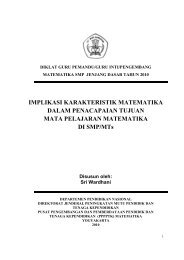25 Biggest Mistakes Teachers Make and How to Avoid Them
25 Biggest Mistakes Teachers Make and How to Avoid Them
25 Biggest Mistakes Teachers Make and How to Avoid Them
Create successful ePaper yourself
Turn your PDF publications into a flip-book with our unique Google optimized e-Paper software.
72 Teacher–Student Relations<br />
On the other h<strong>and</strong>, for shy students<br />
like the author, being called <strong>to</strong><br />
the chalkboard is a terrifying experience.<br />
Shy students are afraid of<br />
exposure <strong>and</strong> are hypervigilant in<br />
their efforts <strong>to</strong> ward off shame.<br />
When they are faced with a barrage<br />
of criticism <strong>and</strong> scornful, disparaging<br />
remarks, like those remarks<br />
delivered by the teacher in this<br />
scenario, they tend <strong>to</strong> internalize<br />
them in<strong>to</strong> a form of “<strong>to</strong>xic shame”<br />
(Bradshaw, 1988, p. 7) that evokes a<br />
sense of worthlessness. Instead of<br />
these students becoming better performers,<br />
they develop fears <strong>and</strong> phobias<br />
about whatever it is that evokes<br />
their shame. The author developed a<br />
fear of talking <strong>to</strong> teachers about<br />
things she didn’t underst<strong>and</strong>. This<br />
type of fear is bound <strong>to</strong> hinder academic<br />
performance, which suggests<br />
that shaming may reinforce poor<br />
performance.<br />
SCENARIO 11.2<br />
Be Still <strong>and</strong> the Shame Will Settle<br />
Reasonable teachers observe a<br />
chalkboard etiquette that dictates that<br />
students should be treated with respect<br />
<strong>and</strong> underst<strong>and</strong>ing whenever they are<br />
forced <strong>to</strong> go <strong>to</strong> the board. These teachers<br />
are patient <strong>and</strong> helpful <strong>to</strong> students<br />
who are trying <strong>to</strong> solve problems.<br />
Judicious teachers rarely use the chalkboard<br />
as a public forum for humiliating<br />
students who don’t underst<strong>and</strong> the<br />
lesson material. They use chalkboards<br />
<strong>to</strong> help students. The board allows<br />
them <strong>to</strong> see the work of several students<br />
at once <strong>and</strong> <strong>to</strong> readily see who is<br />
having problems. They can help the<br />
students in trouble or dispatch other<br />
students <strong>to</strong> the board <strong>to</strong> help. If students<br />
work as teams at the board, it<br />
takes the pressure off individual students<br />
<strong>and</strong> increases the probability that<br />
students will solve the problem as they<br />
work <strong>to</strong>gether. Such a cooperative<br />
effort minimizes the stigma <strong>and</strong> shame<br />
associated with incorrect responses.<br />
In second grade, my gym coach brought it <strong>to</strong> everyone’s attention that I could not do<br />
the required pull-ups for the skills test. This was in front of a gym full of students, several<br />
combined PE classes. It was so embarrassing. There were other coaches around,<br />
but they did not say anything <strong>to</strong> help my pride.<br />
An insensitive gym coach<br />
focused a spotlight of shame<br />
on an unsuspecting student. The<br />
coach sought <strong>to</strong> humiliate her as a<br />
reprim<strong>and</strong> for not doing the required<br />
pull-ups for a skills test. He showed<br />
unabashed contempt for the student<br />
by bringing her shortcomings <strong>to</strong><br />
everyone’s attention. The poor student,<br />
unable <strong>to</strong> escape the glaring<br />
light of shame, felt exposed <strong>and</strong><br />
caught off guard. She felt an inability<br />
<strong>to</strong> cope with the situation <strong>and</strong> looked<br />
around for adult intervention <strong>and</strong><br />
assistance. None was forthcoming.<br />
She felt an inability <strong>to</strong> cope with her<br />
situation in the presence of so many<br />
onlookers. In effect, she was experiencing<br />
shame as embarrassment<br />
(Bradshaw, 1988). This is probably





